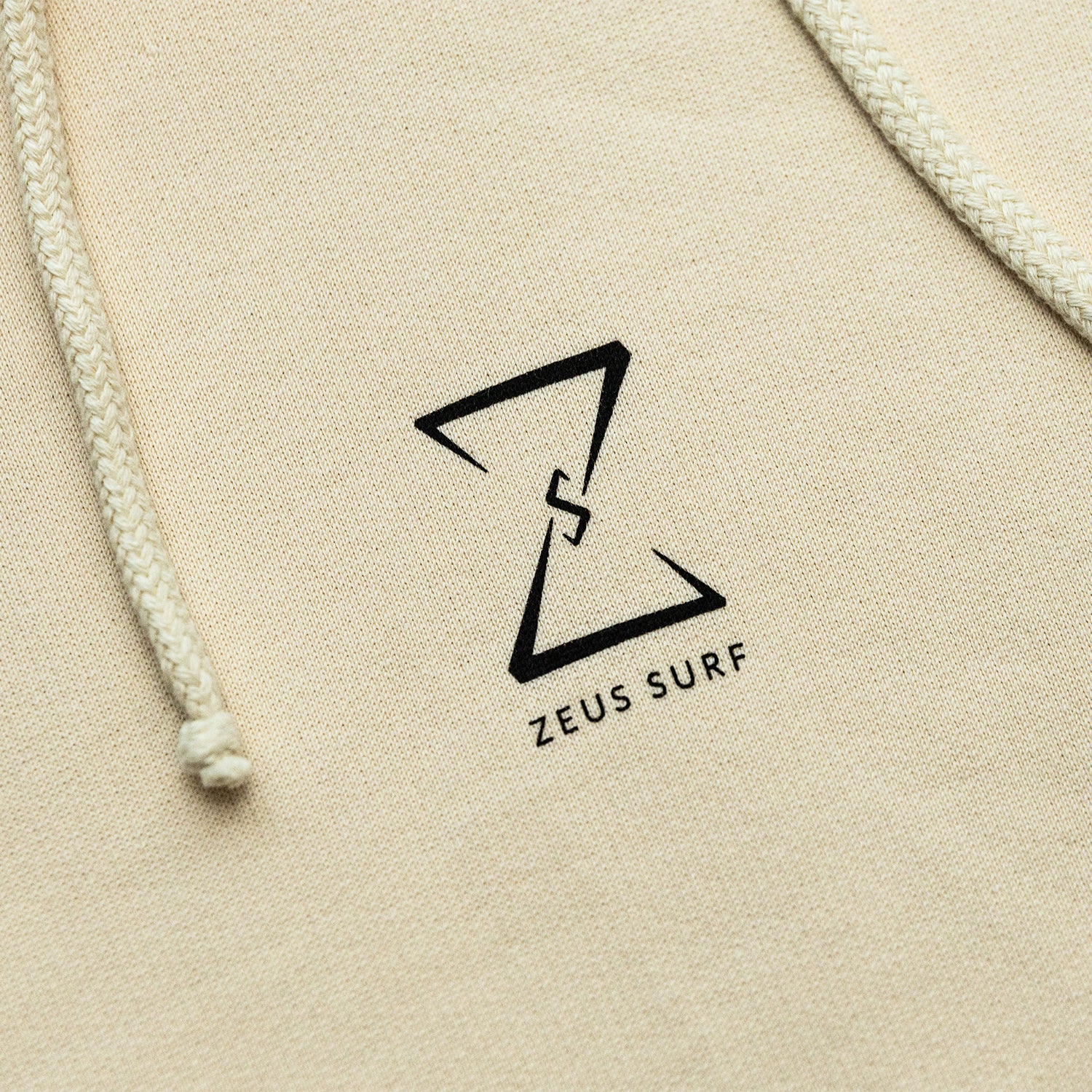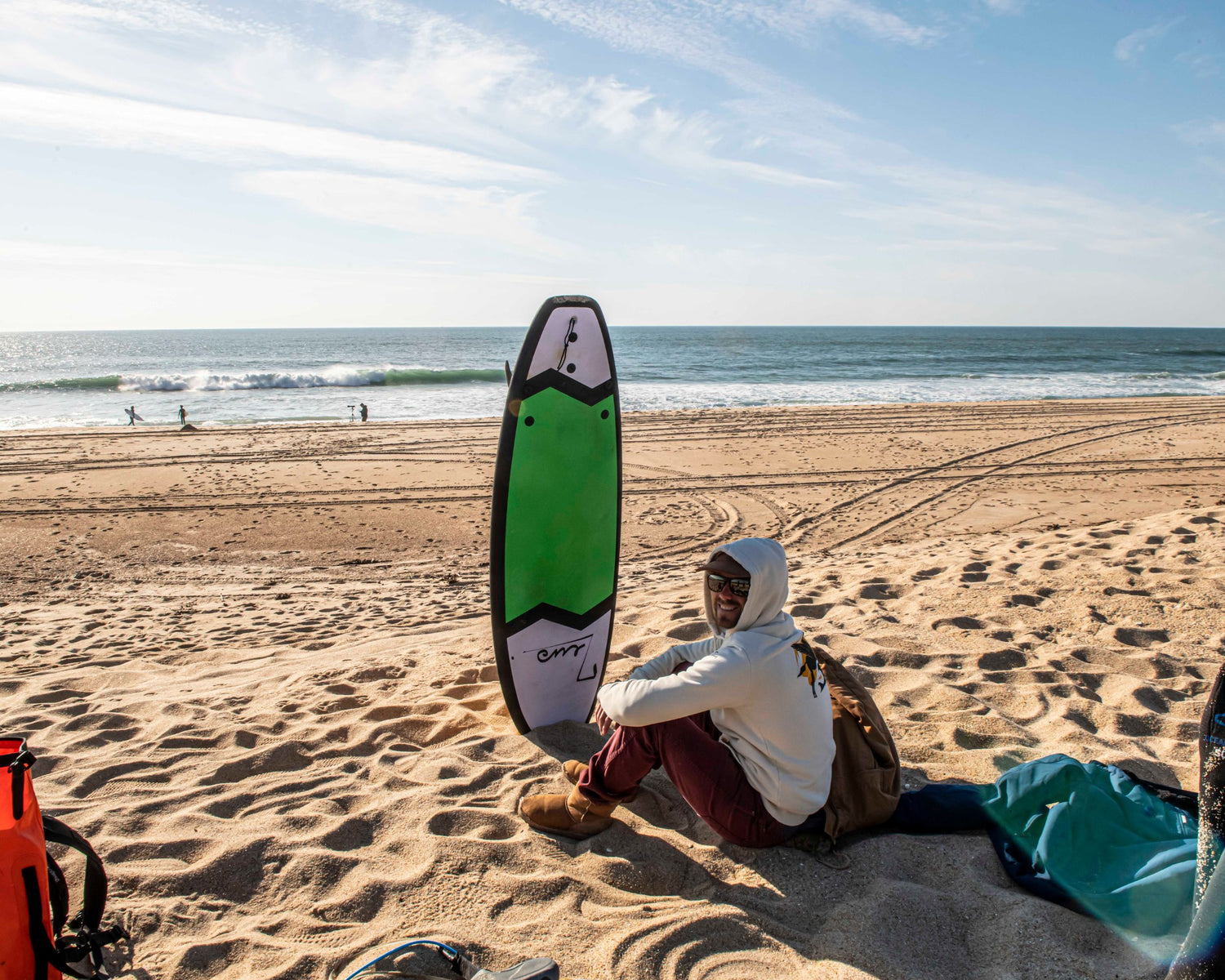Do you dream of becoming a true wave master, able to anticipate the best surfing conditions and enjoy the spots at their best? This guide is for you!
Hold on tight, we're going to uncover all the secrets of Dame Météo , this magician who sculpts the waves out of sight. Armed with this knowledge, you'll finally understand her tricks and be able to choose your surf sessions with complete peace of mind. So, put on your wetsuit and let's go!

The wind, the artist who draws the waves
The wind? For many beginners, it's just a gentle sea breeze. Wrong! The wind actually plays a crucial role in the birth of waves, well before they rise on the spot. We'll explain everything to you!
It all starts on the high seas, where the wind blows unhindered over large expanses of ocean. This is called the “fetch.” The larger this area, the more energy the wind can accumulate to transfer to the ocean and create powerful waves. As you can see: a large fetch = dream waves!
The different winds and their effects on waves
There are 3 main types of wind, each having a very specific effect on the shape of the waves:
- 🌬 Onshore wind, which blows from the sea towards the land, disorganizes the waves and makes them less surfable. This type of wind flattens the waves
- 🌬 Offshore wind, from land to sea, digs the waves and makes them more suitable for surfing. It's the surfers' favorite!
- 🌬 Side shore and side onshore and sideoffshore winds, parallel to the coast or three-quarters. These types of winds can generate irregular but surfable waves depending on their strength. In addition, we will have a preference for the side offshore wind which digs the waves.
Check the wind direction at your favorite spots
Each spot reacts differently to the wind. You need to know the ideal direction for your favorite Line Ups. For example, in Lacanau, the offshore NE wind is optimal, while in Anglet it is the easterly winds that are favorable.
Make a small personalized weather sheet for your favorite spots, it will be very useful!
To plan your next surf trip based on the weather conditions, check out our complete guide on ' How to plan a surf trip '
How to decipher wind weather reports?
To perfectly prepare your sessions, learn to identify two key pieces of information:
- The wind direction forecast.
- Its strength, usually indicated in knots (knots)
- For example, a moderate wind of 10 knots with an offshore orientation is generally excellent news!
- Conversely, too strong an onshore wind is a sign that it is better to postpone your session.
Practical tools to track wind in real time
Many sites and apps like Windy , Surf Report or WindGuru offer detailed forecasts with visualization of wind maps. To be consulted regularly to choose the best time slot and spot according to the announced conditions.
Now you know how to read the wind score to identify the right moments for a crazy session. All that's left is to monitor the forecast and watch for your dream direction to appear!

If you are new to the world of surfing, you can find additional tips in our dedicated article ' Surfing 101: The Ultimate Beginner's Guide ' to better understand the basics of surfing.
Deciphering the swell, the key to finding THE session
The swell breaks from the high seas after a long journey, carrying energy to spare. To choose your spot and your surfing moment, it is essential to uncover the secrets of the swell. We tell you everything about its essential characteristics to decode.
Swell 101: short introduction
The swell is born offshore due to the effect of violent winds unleashed by storms. These winds transmit their energy to the surface of the ocean, generating series of waves that organize themselves into swell. This swell can then travel thousands of kilometers before breaking on the coasts.
Size: how high is the wave?
The height of a swell, measured from the trough to the crest, tells you the size of the waves expected on your spot. Choose it carefully according to your level to avoid unpleasant surprises!
Period: Rhythm and Power
The period refers to the interval between two successive crests. The longer it is, the further the swell has traveled and accumulated energy. A short period indicates small, weak waves, while a long period means consistent, powerful waves.
Direction: Where do the waves come from?
Another key parameter: the direction of the swell. It must be compatible with the orientation of your spot, otherwise watch out for closures! A little check of the direction is necessary.
Energy and power: the winning cocktail
- The energy depends on the height of the waves.
- Power combines height and period: high and long waves will be very powerful.
Your checklist:
Before choosing your spot and time, always check:
- 🌊 The swell height adapted to your level
- 🕰 A long period for more energy
- 🌐 The direction compatible with the site
- 🔎 Detailed weather forecast
With these markers, you will be able to recognize the swells favorable to THE session of your dreams. All you have to do now is refine your reading of the swell maps to spot the hidden treasures!
And now that you know how to read the swell, find out how to choose your ideal surfboard for each condition in our detailed guide ' How to choose your surfboard '

Sculpted by the bottom: understanding the impact of bathymetry
The underwater relief also plays a crucial role in the shape that the waves will take. Analyzing the bathymetry allows you to anticipate where and how the wave will rise before breaking. Follow the guide!
Bathymetry shapes the waves
Mapping the topography of the seabed is essential for predicting wave shapes. Depending on the depth and type of seabed, the energy of the swell is modified.
🌊 Sandy bottom: progressive waves
Sandbanks promote a smooth transition, for generally gentler waves. Great for beginners!
🌊 Rocky bottom: explosive waves
Reefs and rocky bottoms generate steeper and tubular waves. Thrills reserved for experts!
Examples of famous spots in France
Each spot has its own bathymetric signature:
- Lacanau and its shifting sandbanks offer varied conditions.
- The Côte des Basques with its mixed bottoms offers changing waves during a session.
- La Torche and its unique blend of currents and reefs for technical waves.
- Quiberon and its mosaic of seabeds, from soft sand to rocky reefs.

The Breaking of the Waves
Wave breaking is a fascinating phenomenon that creates the very essence of surfing. Understanding how waves break is essential for aspiring surfers looking to master the art of surfing. Let’s dive into this dedicated section to explore the intricacies of wave breaking and how it impacts your surfing sessions.
Wave Formation:
Before reaching the shore, waves begin their journey across the vast ocean expanses. Propelled by the wind, they take shape in the form of swells that propagate over long distances.
Interaction with the Seabed:
As the swell approaches the coast, it comes into contact with the underwater relief. The variation in the depth of the seabed plays a crucial role in how the wave will evolve as it approaches the shore.
Wave Elevation:
When the swell reaches shallower waters, the lower part of the wave comes into contact with the seabed, causing it to slow down. This leads to a rise in the wave crest, creating a separation between the upper and lower part of the wave.
Tilt and Surge:
The inclination of the wave becomes a decisive moment. When the elevation becomes too great in relation to the slope of the seabed, the wave tilts forward, forming the characteristic lip. It is at this point that the wave breaks, creating the dynamic action that surfers seek.
The Magic of the Surge:
Breaking is when the wave releases its pent-up energy. The lip collapses forward, creating that spectacular action that surfers seek to capture. This is when the wave becomes an irresistible invitation for surfers to catch the wave and ride its crest.
By understanding the mechanics of breaking, surfers can anticipate wave behavior and choose the best ones for their sessions. Breaking becomes a dance between the swell, the seabed, and the surfer, where each wave offers a unique opportunity to gracefully glide over the mysterious forces of the ocean. Get ready to feel the energy of breaking during your next surf session!
In conclusion,
There you have it, you now know how to decipher surf weather in the smallest details! The wind , the swell and the seabed no longer hold any secrets for you.
All you have to do now is put this knowledge into practice during your next sessions to feel the difference. Analyze the conditions well, choose your spot, your direction and your moment. The rest will come with experience and practice.
Remember to regularly check the weather forecast , check the wind direction and strength, as well as the size, period and direction of the swell. Use online tools and dedicated applications to monitor weather conditions in real time and choose the best time to surf.
Finally, remember that safety is paramount. Don't take unnecessary risks and follow local safety guidelines. Always surf within your limits and be aware of the dangers of the ocean.
So, get your board ready, study the weather forecast, analyze the conditions, and get out there and conquer the waves. With this ultimate guide to taming surf weather like a pro, you’ll be ready to enjoy every session and become the wave master you’ve always wanted to be. Happy surfing!
FAQ: Guide to Understanding Surfing Weather Forecasts
How to interpret the size of the swell for a successful surfing session?
Swell size, measured in meters, indicates the height of ripples in the open ocean. However, actual wave size can vary depending on the spot, wind, and other factors. Check your spot-specific forecast for more accurate indications.
What impact does wind have on wave quality?
Offshore wind, blowing from the land to the ocean, is ideal because it shapes and digs waves, sometimes creating tubes. Conversely, onshore wind, coming from the ocean to the land, degrades the quality of the waves by crushing them, causing chop. A tiny wind is optimal for surfable conditions.
How does the tide influence surfing sessions?
The rising tide is usually favorable 2-4 hours after the start, but it depends on the swell. On the other hand, the falling tide can reveal underwater obstacles and cause breaking waves in shallow water. Consult the locals to know if a spot works better on a rising or falling tide.
What role does the coefficient play in the safety of surfing sessions?
A high coefficient (above 75) can make currents violent, especially with a big swell. A medium/low coefficient (below 75) indicates less violent currents. It is crucial to consider the coefficient, especially in case of extreme weather conditions.
How does wave period affect the surf session?
The period represents the time between two waves. A long period (greater than 12) will space the waves apart, increasing their size. A short period (less than 8) will bring the waves closer together, potentially decreasing their size and quality. An ideal period is around 10-11 for consistent waves.
How do I know if the conditions are optimal for a surf session?
To identify a good session, ask yourself these questions:
- Does the swell size match your skill level?
- What is the wind strength and direction? Is it offshore or onshore?
- At what tide does the spot work best?
- Is the wave period suitable (between 10-11)?
Check the detailed weather forecast to answer these questions and maximize your surfing experience.









